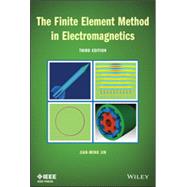The finite element method (FEM) is a powerful simulation technique used to solve boundary-value problems in a variety of engineering circumstances. It has been widely used for analysis of electromagnetic fields in antennas, radar scattering, RF and microwave engineering, high-speed/high-frequency circuits, wireless communication, electromagnetic compatibility, photonics, remote sensing, biomedical engineering, and space exploration.
The Finite Element Method in Electromagnetics, Third Edition explains the method’s processes and techniques in careful, meticulous prose and covers not only essential finite element method theory, but also its latest developments and applications—giving engineers a methodical way to quickly master this very powerful numerical technique for solving practical, often complicated, electromagnetic problems.
Featuring over thirty percent new material, the third edition of this essential and comprehensive text now includes:
- A wider range of applications, including antennas, phased arrays, electric machines, high-frequency circuits, and crystal photonics
- The finite element analysis of wave propagation, scattering, and radiation in periodic structures
- The time-domain finite element method for analysis of wideband antennas and transient electromagnetic phenomena
- Novel domain decomposition techniques for parallel computation and efficient simulation of large-scale problems, such as phased-array antennas and photonic crystals
Along with a great many examples, The Finite Element Method in Electromagnetics is an ideal book for engineering students as well as for professionals in the field.








